RogueRose
International Hazard
    
Posts: 1585
Registered: 16-6-2014
Member Is Offline
|
|
Very strange behavior when melting lead - getting a THICK orange oxide layer on top
I've melted a lot of lead in my days, going back to when I was 9-10 years old, and I have NEVER seen what has just happened. I was using an electric
stove top with a stainless bowl to melt the lead. I started off with 5lbs to melt then added 3 2.5lb round billets to it. I had the temp set at
~7-7.5 out of 10 so it was just barely a slight glow of red on the element.
I placed a slightly larger stainless bowl over it, the top lip diameter is just about exactly the same as the burner diameter, and it gave about
.5-.75" clearance above the bowl with lead in it. I figured this would help speed the melting by keeping the heat inside the upside down larger bowl.
Well I got side tracked and about 2 hours later I came back to see what looked like the crusty surface of Mars. It had formed a solid layer of oxide
on the top that could be broken up, but I'd have to guess the thickness to be about .15-.25" depending on where it was measured as there were what
looked like mountains that had formed in various areas.
I crushed up the oxide and scooped it off leaving a perfectly clean layer of lead. Since I was working with large multi-cavity molds, from 6-18
cavities each, and using many molds at once, I turned the temp up to high and the castings went perfectly. At one point I thought i would take a few
min break to allow the handles to cool down, but it ended up being 4-5 hours (with it remaining on high - and uncovered). When I came back it looked
almost the same as when I left it, but with just a slight bit of lighter grey oxide on the top. I'd say it was about 1/50th (AT MOST) of the oxide
from the first heating.
I cast some more, added more billets, cast more and decided to quit for the day w/ about 3/4 of the bowl filled. It solidified fine and the next day
I heated it the same way, with the larger container flipped over and I got the very thick orange oxide layer again and this time it was on high while
it heated but I didn't heat it for as long.
So now I'm convinced that heating th elead with it covered like that produces this lead oxide which I find counter-intuitive b/c this has never
happened when I leave it uncovered no matter the temp (even much higher than the high on THIS stove is capable of.
So can anyone explain why this oxide layer forms when it's covered the way it was - and also not form an oxide layer (well, NOTHING close to what I
saw while it was covered.
**Side note: I'm looking for a way to melt down battery lead but am having a hard time b/c it all seems to act much differently than standard lead,
except for a few parts like at the top of the plates that join them all together (bus/cell bars basically)- that is pure lead, as well as SOME of the
lead in the lattice/grid structure but the "sponge lead" that is pressed into the grid/plates does not act like the same kind of lead nor does it melt
easily.
|
|
|
RustyShackleford
Hazard to Others
  
Posts: 195
Registered: 10-12-2020
Location: Northern Europe
Member Is Offline
|
|
Do you have pictures? perhaps it still contained a large amount of metal, just didnt settle out nicely.
|
|
|
valeg96
Hazard to Others
  
Posts: 253
Registered: 6-4-2014
Location: Italy
Member Is Offline
Mood: Moodless
|
|
You probably know this already but the lead in the plates is spongy lead, which does not melt along the lead that makes the frames. To use that you'd
have to dissolve it in some acid and process it from there.
|
|
|
RogueRose
International Hazard
    
Posts: 1585
Registered: 16-6-2014
Member Is Offline
|
|
Quote: Originally posted by valeg96  | | You probably know this already but the lead in the plates is spongy lead, which does not melt along the lead that makes the frames. To use that you'd
have to dissolve it in some acid and process it from there. |
I've tried probably no less than 40 ways to melt lead from battery plates and have never had GOOD luck. I might get 10% yeild as useable, melted lead
- the rest is a strange oxide.
I've even dissolved it in 3 different acids and used different methods to precipitate the lead, or to heat it (boil off the acid), it always came back
to a spongy lead that wouldn't melt. Once I tried lead acetate and used fine shavings of pure Mg, and I got a nice large lead ball (it all stuck
together) but upon heating it just WOULDN't Melt! It formed the same color grey powdery substance like you get from old car battery plates - it
rubbed off very easily and turned to almost 100% oxide when heated (I tried propane, butane, acetylene, oxy-acetylene and a 1800F electric heating
element. Beleive me, I've tried SO MUCH in this area, there is just something odd with battery lead.
One positive note, I used quartz tube (14mm diam, cut one side open and the other side was pinched closed as it was an old 1500w halogen bulb). I
drilled a small hole about 3mm and filled that end with pure lead oxide (orange/yellow). I then used cotton stuffed in the tube, heated over propane
flame both the oxid e& the cotton, and blew air through it. THIS reduced it nicely but y
eilds were low but it worked "well" in comparison. I'd really like to make a new setup for this but not sure how raise oxide above molten lead, heat
it, and blow CO &/or H2 into it.
The lead I was using is old bullets, old fishing weights, scuba weights, etc. It melted like a dream but formed this crusty surface. My cell phone
wasn't charged at the time so I couldn't take pics before I scraped it off, but I'll take pics of what's left.
|
|
|
Fyndium
International Hazard
    
Posts: 1192
Registered: 12-7-2020
Location: Not in USA
Member Is Offline
|
|
I had little success when melting battery lead. It was drained, though and should have been charged first, so mostly lead sulfate was obtained. It
formed only drops of molten lead upon heating. Another batch with charged battery did produce more, but the yield was still very far from useable
amount, and the oxidized lead should be reduced with CO or H2 at extreme temp.
|
|
|
RogueRose
International Hazard
    
Posts: 1585
Registered: 16-6-2014
Member Is Offline
|
|
So here are some pictures of what the oxide looks like. The stuff that is more yellow & orange was the first batch, and then the stuff that is
more brown was when I heated the same lead a second time (just added 3 more ingots and turned it on high for a couple hours - yeah it was a little too
long, but at least I found this interesting).
On a side note, I can keep the lead on the same burner, uncovered, and on high for as long as I want (24+ hours) and it doesn't make any oxide layer
like this. At most it forms what is similar to "soup skin" that is very thin, maybe 1/4-1/2mm in thickness and it isn't hard like the stuff in the
pics, it just has a slightly more firm texture than the pure/shiny skimmed lead.
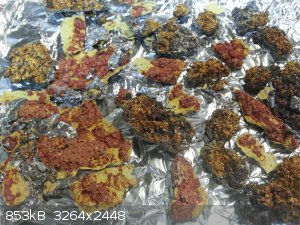 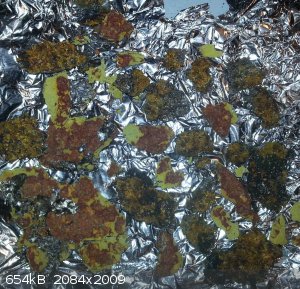 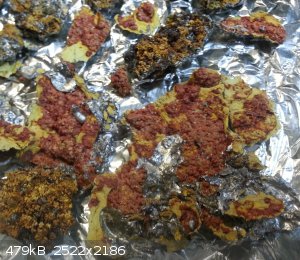 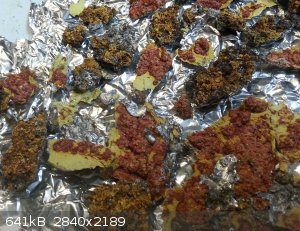 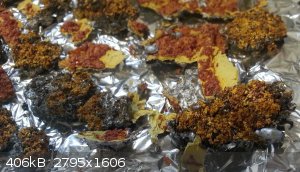 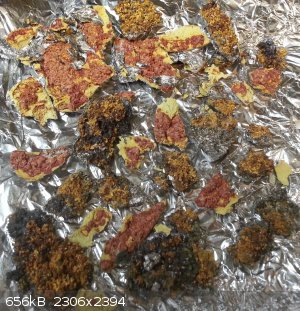
|
|
|
Fulmen
International Hazard
    
Posts: 1693
Registered: 24-9-2005
Member Is Offline
Mood: Bored
|
|
My guess would be high temperature due to improved insulation. The power setting on the hotplate does not automatically correspond to any temperature.
I've seen the same thing happen with lead left hot for too long.
As for your problems melting finely divided lead, it sounds like oxidation from air exposure. As you already have noted, lead is easily oxidized in
air. You may need to heat it under a protective or reducing atmosphere.
We're not banging rocks together here. We know how to put a man back together.
|
|
|